4 Easy, Pretty, and Edible Planting Designs
These beds look just as good as flower gardens, except you can eat what’s planted in them
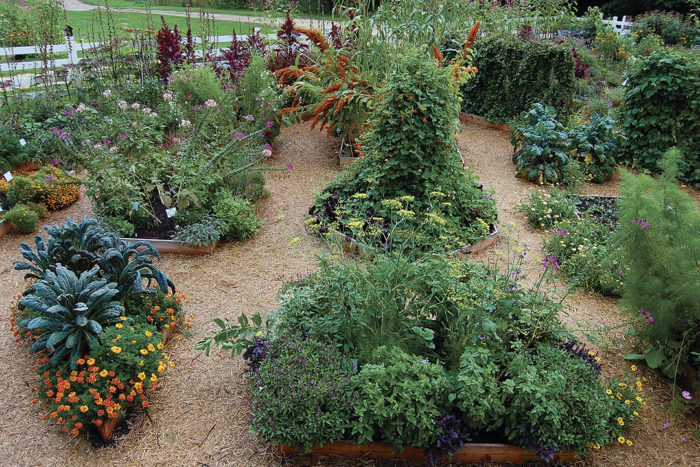
I consider myself pretty lucky to have thousands of heirloom vegetable, flower, and herb varieties in my backyard—which happens to be Seed Savers Exchange’s Heritage Farm in Decorah, Iowa. Although beautiful in their own right, these fields of edibles aren’t exactly picturesque because they are planted for the sole purpose of harvesting and preserving seed. To better showcase the beauty of edibles, we decided to transform an area next to our barn into a productive—yet good-looking—garden plot. Visitors love the new gardens so much that they often ask us how they can create similar plantings.
Anyone can have edible gardens that look as good as they taste. I’ve blended more than 250 different plant types in this one space, all serving ornamental and practical purposes. While I don’t expect anyone to go that far, the following are some of my favorite raised-bed planting plans, which use some of the most attractive edibles available.
You can’t grab this box of popping corn at the market
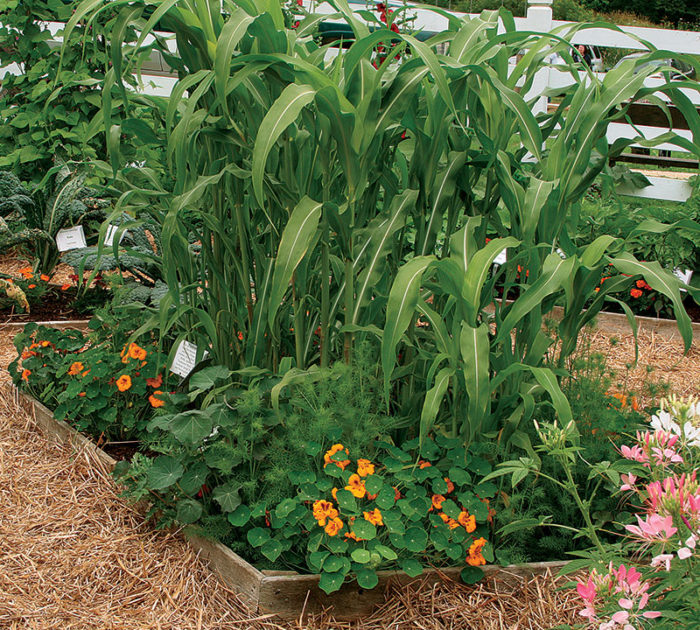
What to build: A 3-foot-square raised bed |
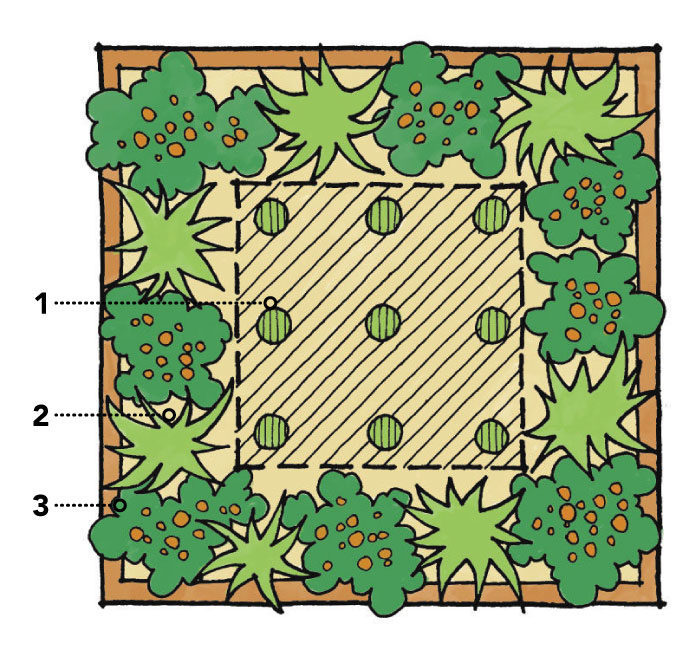
Direct-sow ‘Tom Thumb’ popcorn 10 inches apart in a block in the middle of the box. Fill in around the corn and to the edge of the box with nasturtiums. Space those seeds 1 foot apart. For a different color scheme, use ‘Strawberry’ popcorn instead of ‘Tom Thumb’ and mix in strawberry spinach, a self-seeding annual, with the nasturtium. The spinach is showy and has nutritious triangular leaves, which can be steamed or used in salads; its red fruit is edible, too. The popcorn adds a vertical focal point, while the beautiful (and edible) nasturtiums and spinach make productive use of the thin perimeter.
What to plant
1. ‘Tom Thumb’ or ‘Strawberry’ popcorn
2. Nasturtium (Tropaeolum spp. and cvs., annual)
3. Strawberry spinach (Chenopodium capitatum, annual)
Peas planted on a curve are a sight to behold
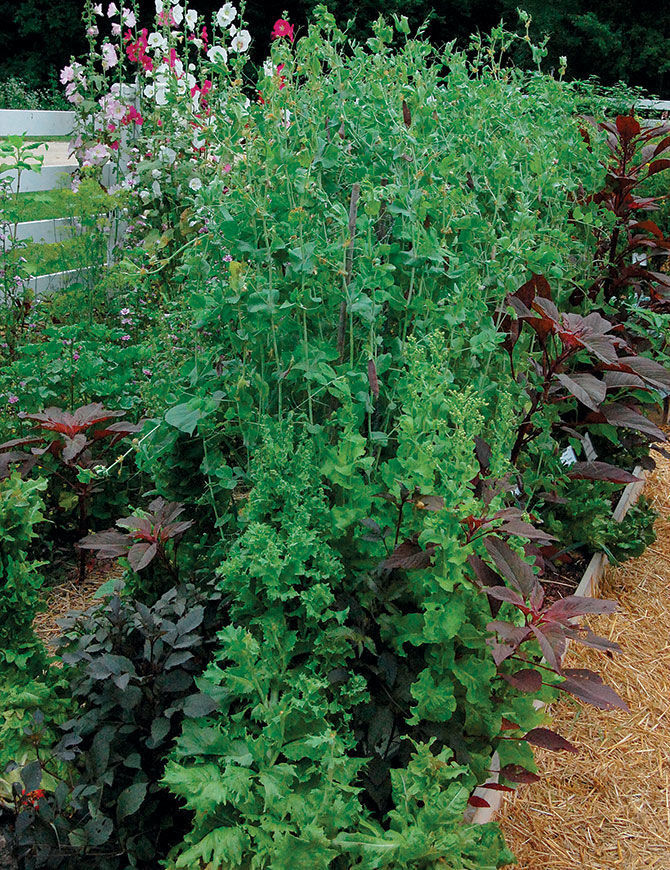
What to build: A rectangular raised bed, 13 feet long and 3 feet wide. Set chicken wire down the center in the shape of an S-curve, securing it on either end with a sturdy wooden stake. |
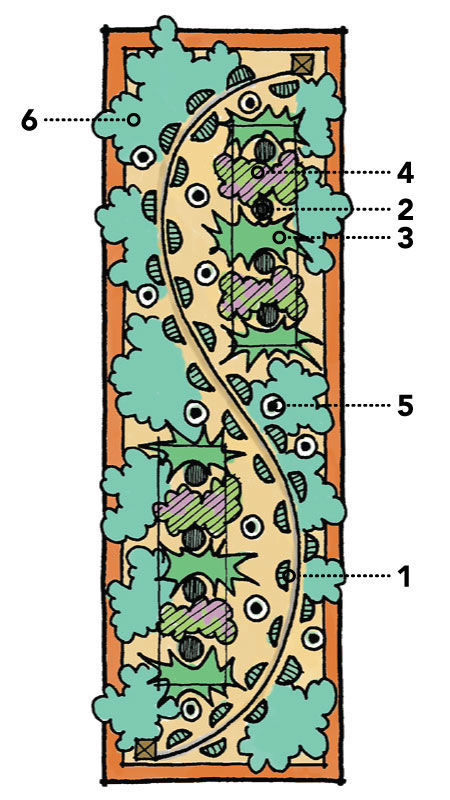
Direct-sow the ‘Blue Podded’ shelling peas along the bottom of the chicken-wire trellis, spaced 2 to 4 inches apart. Plant wild celery in a rectangle, 1 foot away from the trellis and spaced 8 inches apart. Between the celery, alternate planting the lettuces and dahlias—lettuces between one pair of celery and dahlias between another. This gives the entire bed a color-block appearance, which is stunning. Randomly plant the leeks throughout the bed; as they grow taller, they will end up looking like giant fireworks exploding from the foliage below. Complete the design with low growers, like sweet alyssum, placed at the very edges of the bed and poking out from underneath the lettuce leaves.
What to plant
1. ‘Blue Podded’ shelling peas
2. Wild celery (Apium graveolens, USDA Hardiness Zones 8–9)
3. Lettuce, assorted mix of colors
4. ‘Bishop’s Children’ dahlia (Dahlia ‘Bishop’s Children’, Zones 9–11) ✦
5. ‘Prizetaker’ leek
6. Sweet alyssum (Lobularia maritima, annual) ✦
✦ Nonedible plants
What to build: An octagonal raised bed, each side 7 feet long. Make a tepee out of eight large bamboo poles at the bed’s center. Each pole should be stuck into the ground at an angle and tied at the top with twine. |
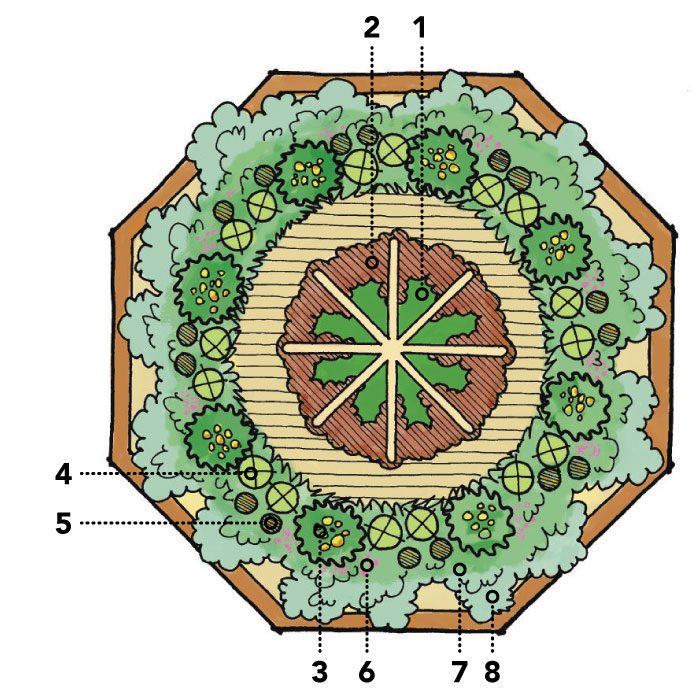
Direct-sow the ‘Scarlet’ runner beans 6 inches apart at the base of the tepee so that they’ll be able to climb it. This structure provides a focal point in an edible bed while serving as a sturdy support for the rambunctious runner beans. Working 1 foot out from the tepee, direct-sow the ‘Bull’s Blood’ beets in a circle; the seeds should be spaced 3 inches apart. Beets are just as pretty as any ornamental-foliage plant, and they tolerate a wide range of soils without complaint. Another 6 inches out from the beets, transplant African daisies, spaced 1 foot apart around the outer circle of beets. Between the African daises, plant a couple of ‘Spicy Globe’ basils (which stay nice and compact) and a couple of ornamental peppers. Plant low growers, like moss rose, sensitive plant, and sweet alyssum, so that they spill over the very edges of the octagon, softening its sides.
What to plant
1. ‘Scarlet’ runner bean
2. ‘Bull’s Blood’ beet
3. African daisy (Osteospermum spp. and cvs., annual) ✦
4. ‘Spicy Globe’ basil
5. Ornamental pepper
6. Moss rose (Portulaca grandiflora cvs., annual) ✦
7. Sensitive plant (Mimosa pudica, Zones 12–13) ✦
8. Sweet alyssum ✦
Three big flavors in an attractive three-sided bed
What to build: A triangular raised bed, 5 feet long on each side |

Set out the ‘Red Russian’ or ‘Lacinato’ kale as soon as the soil can be worked in spring. Choose only one variety (don’t mix them) because it makes a greater impact visually when all of one kind is massed together. Plant three to five kale plants (spaced 7 inches apart) at the center of the bed. Working out 1 foot from the kales, fill the box with parsley, spaced 6 inches apart. Place one ‘Red Marietta’ marigold in each corner of the bed. The fine texture of the parsley and marigolds help the puckered-skinned kales shine as the focal point in this bed.
What to plant
1. ‘Red Russian’ or ‘Lacinato’ kale
2. ‘Triple Curled’ or ‘Italian Flat Leaf’ parsley
3. ‘Red Marietta’ marigold (Tagetes patula ‘Red Marietta’, annual)
I can grow popcorn?
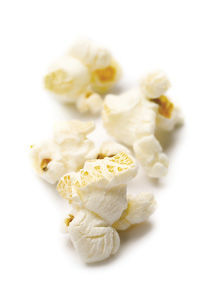
Yes, you can. Popping corn is small in stature and has a short maturity time. Popcorn’s dried kernels burst when heated because the moisture inside converts to steam and turns the seed inside out (making a popping sound). Growing popcorn is easy as long as you have full sun. Allow the ears to dry on their stalks until the kernels are hard and the husks are completely dry. Harvest; remove the husk; and dry the ears in a warm, dry, well-ventilated place. To test the popcorn for readiness, I pluck off a few kernels (once or twice a week) and try to pop them over the stove burner. When the test kernels pop well, I pull all of the kernels off the cobs and store them in an airtight jar. Enjoy it whenever you want a homegrown snack.
Diane Ott Whealy is the cofounder and vice president of Seed Savers Exchange in Decorah, Iowa.
Photos, except where noted: David Cavagnaro
Illustrations: Martha Garstang Hill, colorized by Bill Godfrey







Comments
Log in or create an account to post a comment.
Sign up Log in